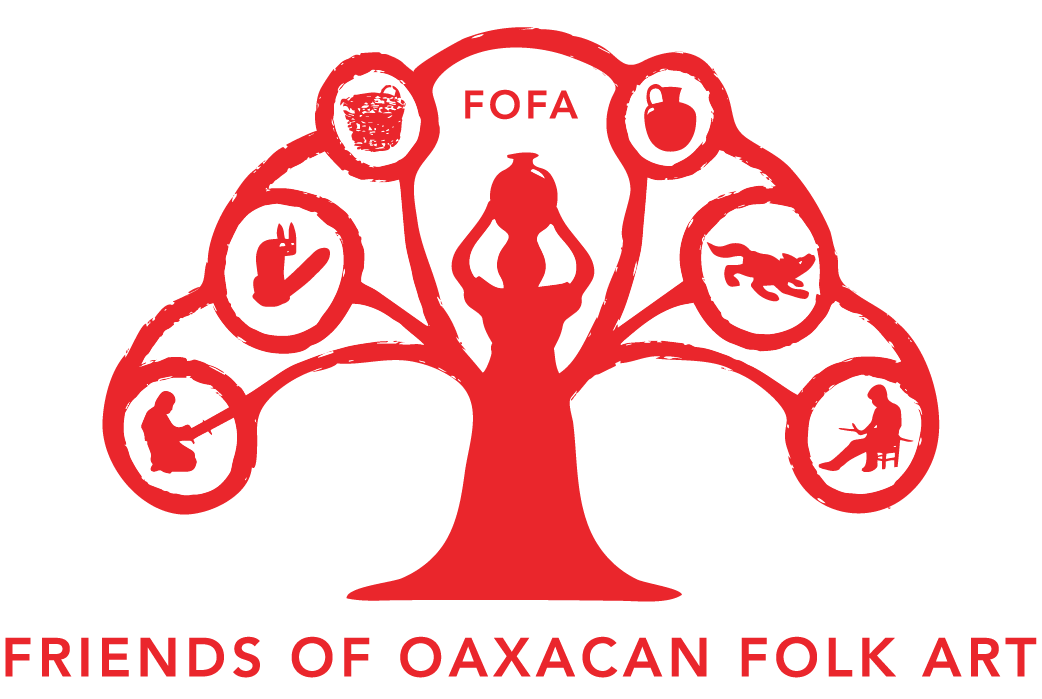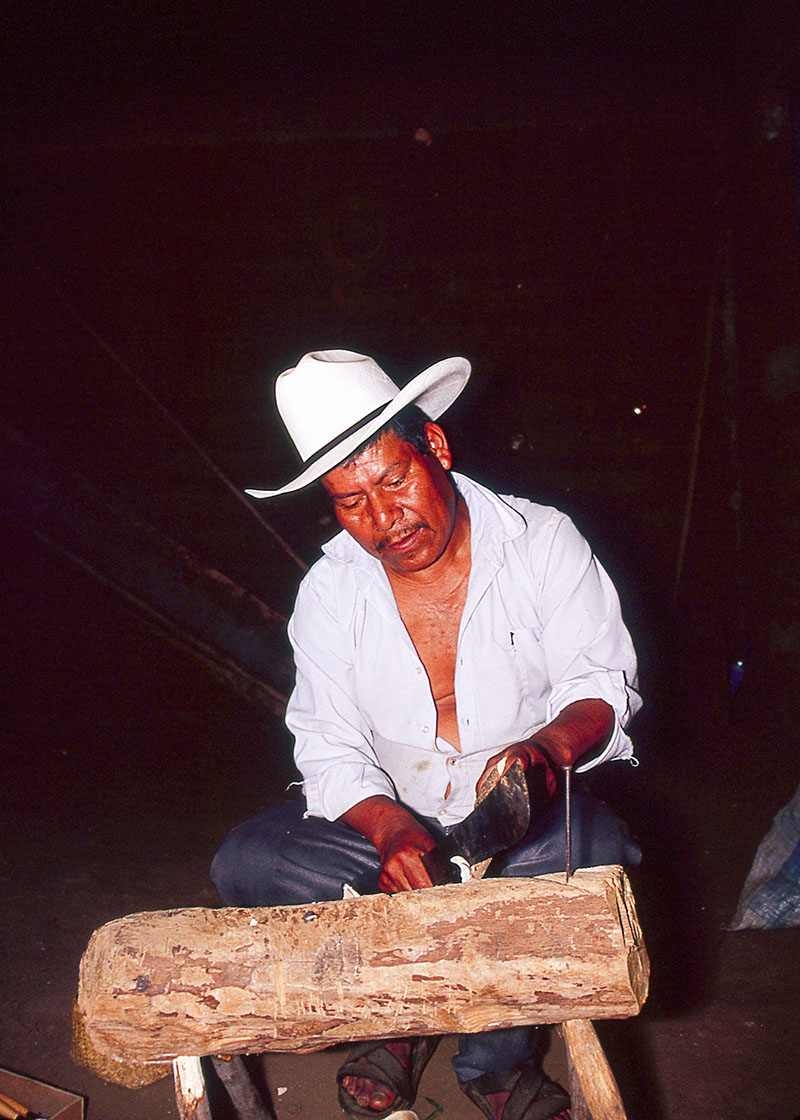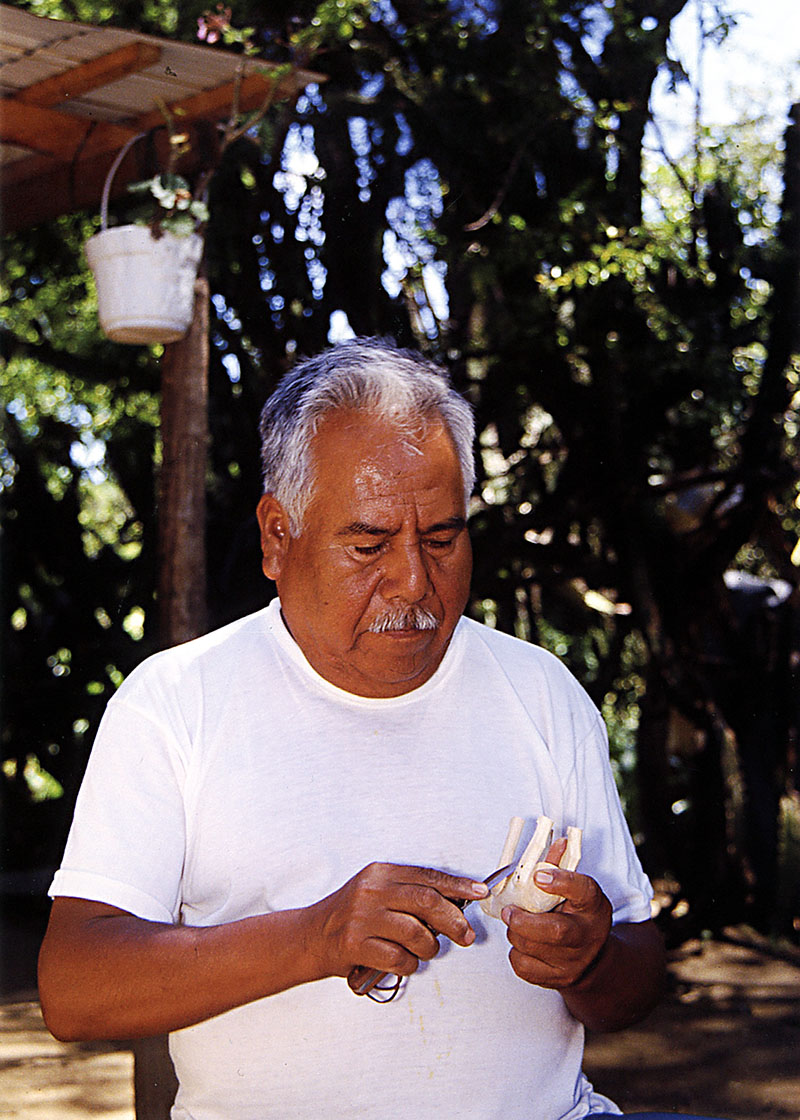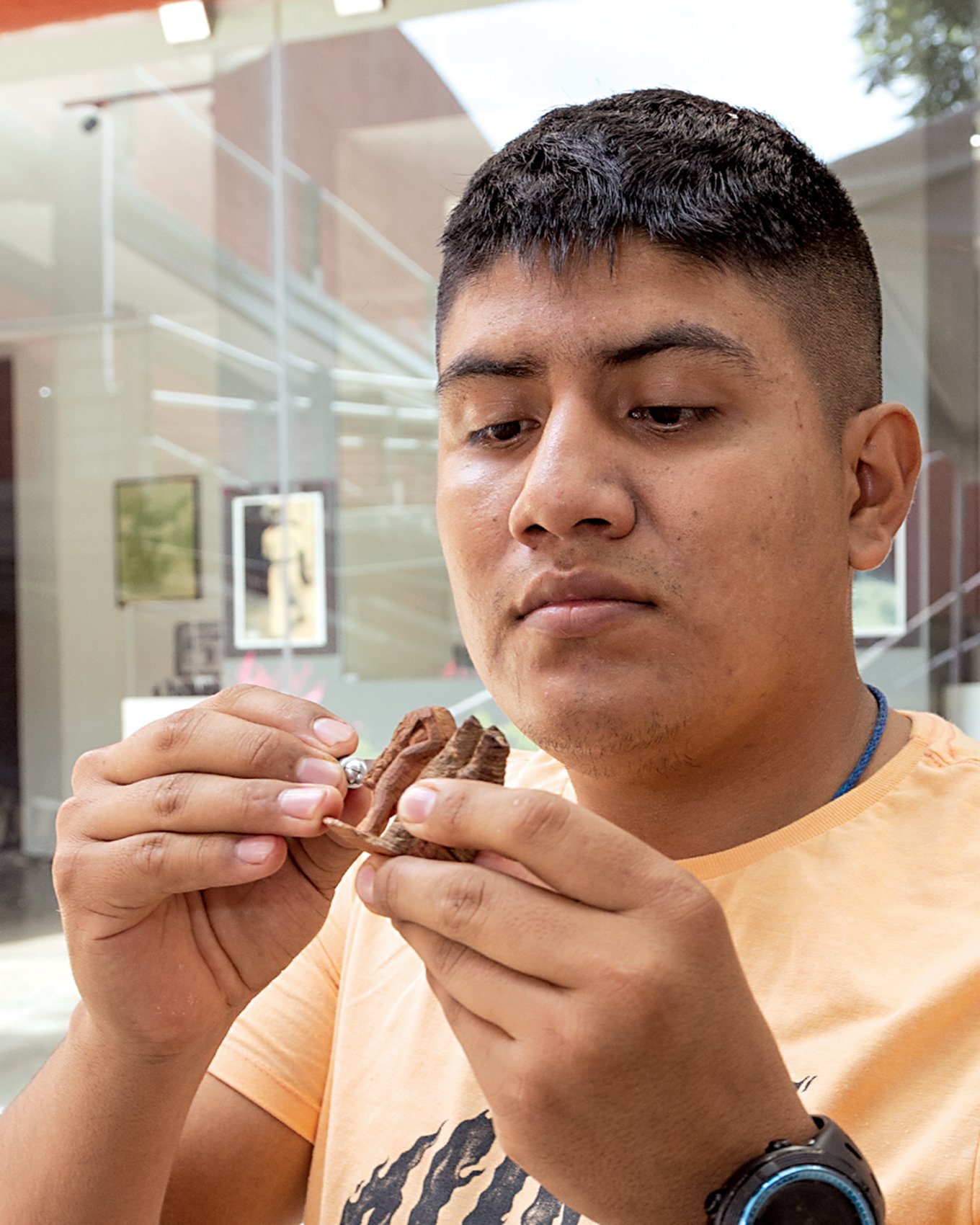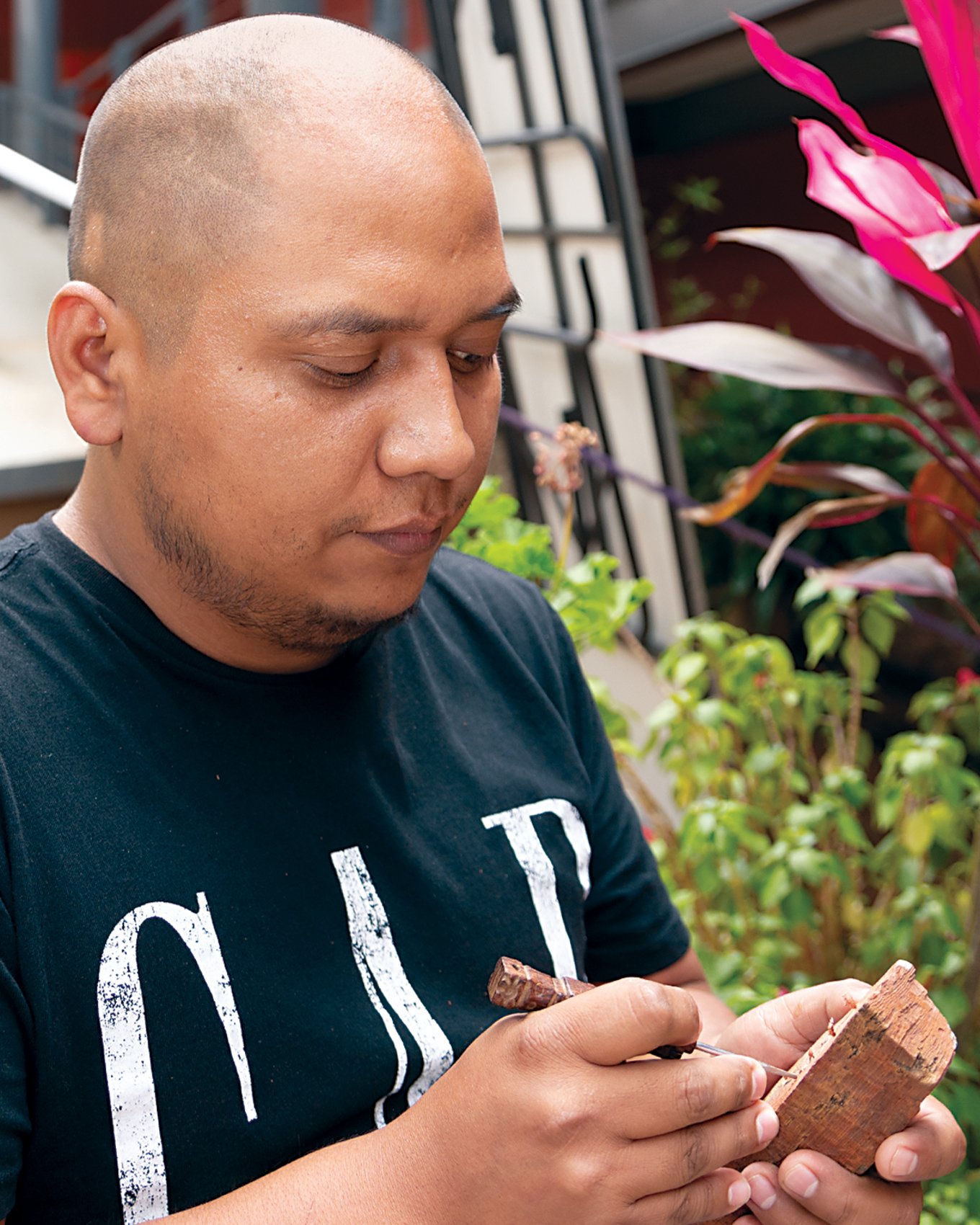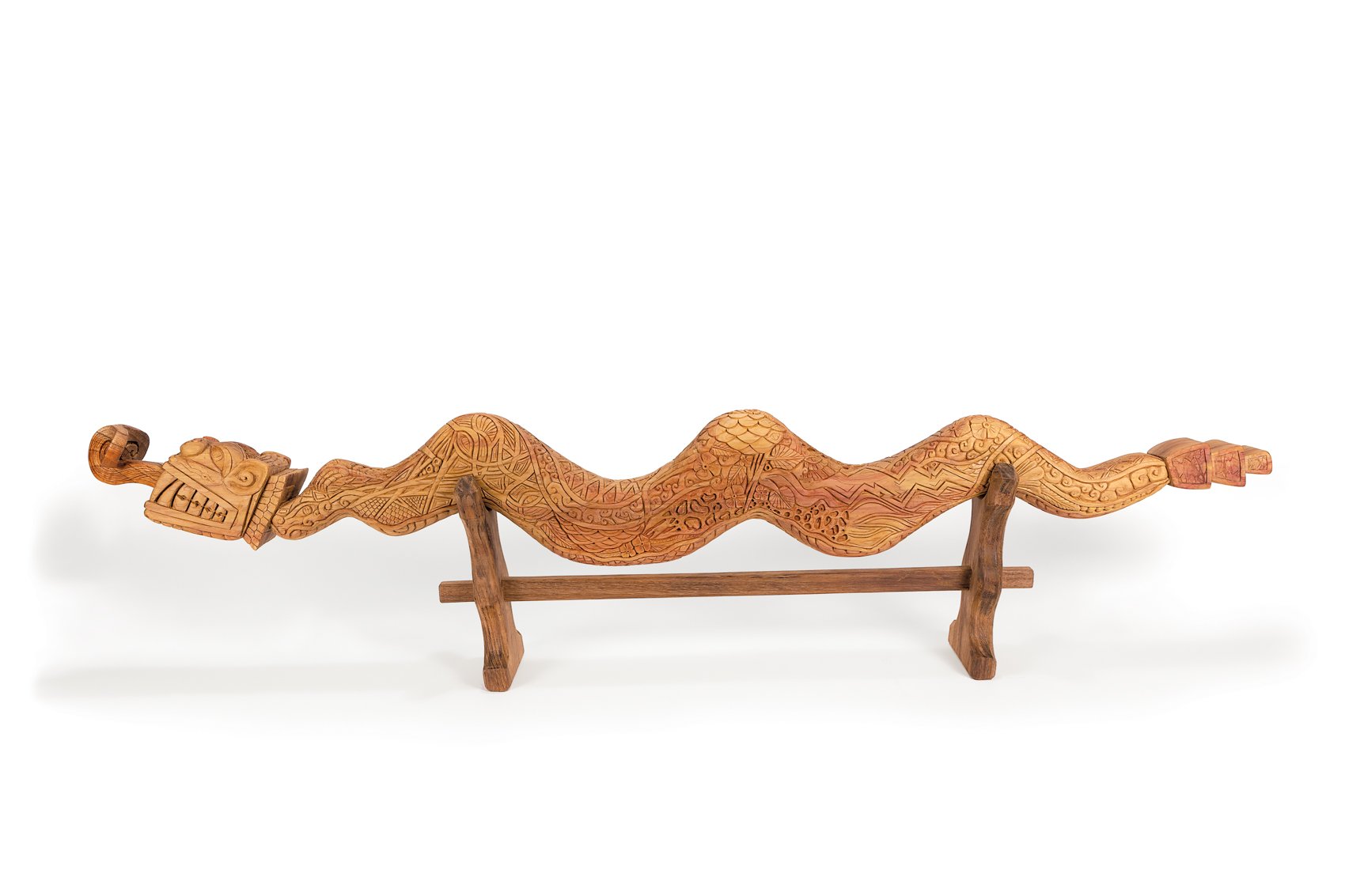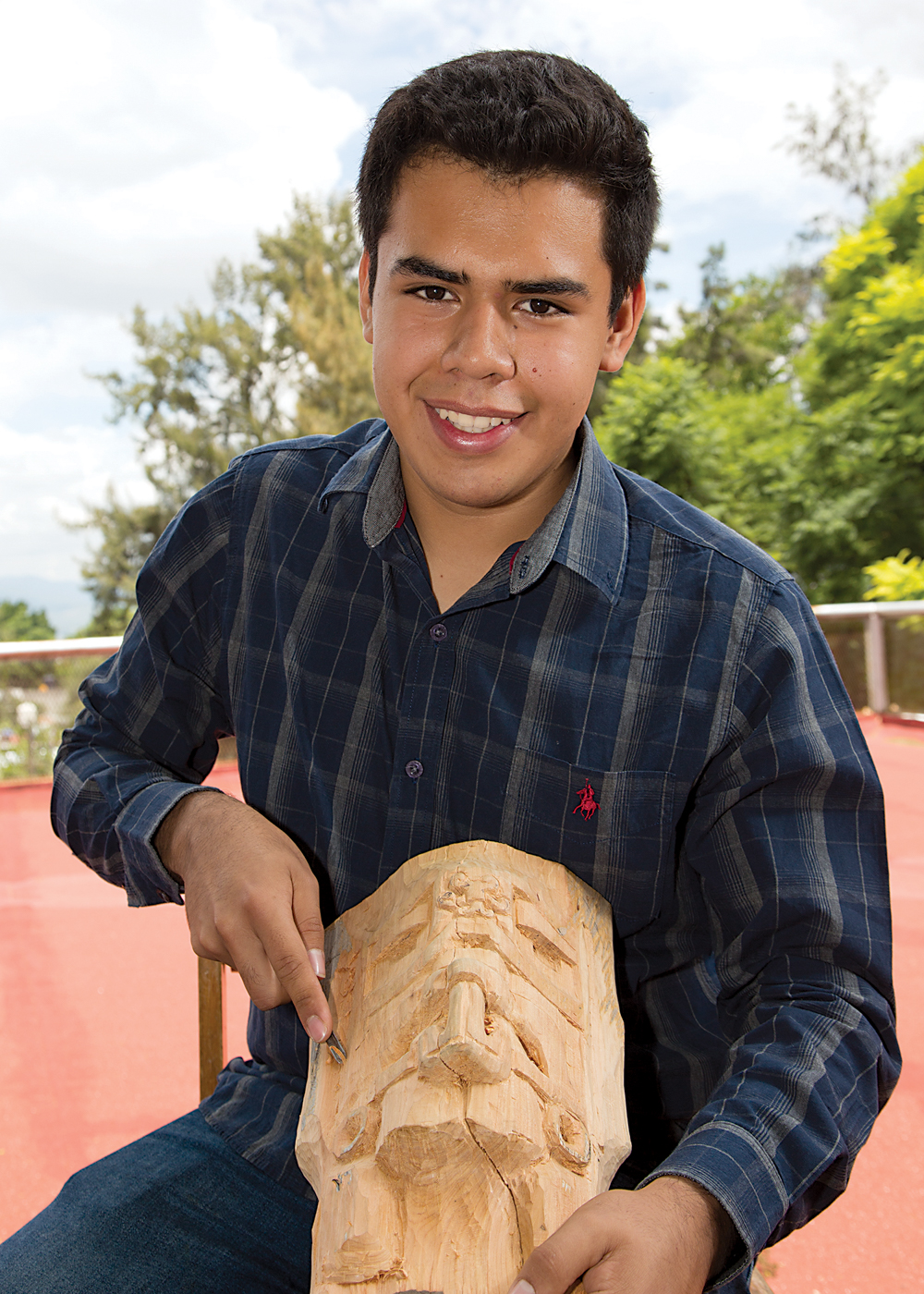meet the artists
WOODCARVING
The Artists: Page One
Painted woodcarving is an art form undertaken primarily in three pueblos surrounding Oaxaca City: San Antonio Arrazola, San Martín Tilcajete, and La Unión Tejapalam. In addition, one family of woodcarvers can be found in San Agustín de las Juntas; one individual carver is listed in Miahuatlán de Porfirio Díaz; and another two live in Santa María Atzompa. Woodcarving is a relatively new art form in Oaxaca. Unpainted religious masks and small toys for children have long been an important part of the culture. However, painting animal, human and fantasy figures for purely decorative purposes, was introduced only in the 1950s, gaining recognition in the 1980s in response to soaring demand by American folk art dealers.
Many people incorrectly refer to this entire class of art as alebrijes, the fantastical monsters combining features of a variety of animals for which Pedro Linares (1906-1992) -- working in papier mâché in Mexico City – became famous. While some Oaxacan woodcarvers do create monsters, many pieces treat subjects of natural beauty (such as animals or cacti), religious beliefs, or fantasy material grounded in myths or cultural traditions (for instance, nahuales – figures with both human and animal features– that are also captured in many types of ceramics). Other artists work in natural wood only, leaving their sculptures unpainted.
La Unión Tejalapam
Many of the artisans of this pueblo have neither telephones nor access to email. Their addresses are often listed as Domicilio Conocido (known address), which simply means that their houses do not have a street name or number. When visiting this pueblo, feel free to ask for directions to the artist you wish to visit.
Avelino Pérez Muñoz
Pueblo of La Unión Tejalapam
Llano Coyote s/n
(From US) Cell: 011-52-951-363-5840
(Daughter’s cell to text photos): 011-52-951-360-6955
(In Oaxaca) Cell: 951-363-5840
Daughter’s cell to text photos: 951-350-6955
In contrast to the typically more primitive, although charming, style of his fellow artists in this pueblo, Avelino’s pieces are extremely fine and have more contemporary lines. Inspired by cartoons, his work is also noted for its playful quality, e.g., animal musicians (toucans, roosters, goats to name a few) singing with their microphones. He also creates irreverent angels with one wing up and the other down. Avelino did not grow up in an artisanal family but rather taught himself to carve at the age of 30, encouraged by his cousin to paint. He uses acrylic paints with very fine brush strokes, in contrast to the other artists in his village who use aniline paints.
Gabino Reyes López
Pueblo of La Unión Tejalapam
Domicilio Conocido
gabyrey19@hotmail.com
(From US) Cell: 011-52-951-226-8774
(In Oaxaca) Cell: 951-226-8774
Gabino’s elaborate carving style stands apart the predominately rustic products one finds in the pueblo of La Unión. He creates finely-detailed carvings, such as his Virgin of Guadalupe, replete with a bouquet of delicately-colored flowers. It is Gabino’s intention to surprise his visitors with the expansiveness of his imagination. For instance, he carves a classic black and white cow; however, on its belly is the Virgin, below which is a table whose legs double as teats for the calf that accompanies its mother. By wedging cactus fiber into crevices in a carved donkey’s mouth, he suggests it is chewing alfafa. Gabino does all the highly detailed carving of his pieces, while his wife does the majority of the painting. It is uncommon to find pieces available for sale since he works predominantly on commissions.
The Santiago Family
This is the most well-known carving family in La Unión. There are four living brothers – Francisco, Martín, Plácido, and Quirino – and many of their sons and nephews carve as well. Painting is typically carried out by spouses or daughters.
Francisco Santiago Cruz (brother)
Pueblo of La Unión Tejalapam
Domicilio Conocido
Francisco, the eldest of the brothers, stopped working in 2017, years after suffering a stroke that limited his use of one arm. He was known for his wonderful scenes and enchanting female figures holding bouquets, market produce, and other local items. Their serene expressions and graceful forms are distinctive. Despite his stroke, Francisco was able to continue carving figures that convey delicacy and sincerity.
Martín Santiago Cruz
Pueblo of La Unión Tejalapam
Domicilio Conocido
Zona de la Cañada Cera s/n
Martín, a warm and welcoming man, works surrounded by his extensive family. His signature pieces are primarily religious in nature: nativity scenes, Noah’s arks, virgins and angels. His figures are thoughtfully adorned with highly detailed accessories; he might carve recesses into a virgin’s hands so that she may cradle a small bouquet of flowers. To reach Martín’s home, be prepared to hike on foot through goat pastures and up hilly fields of corn. Despite his prodigious talent and productivity as a woodcarver, farming remains his first love and dominant self-image.
Plácido Arturo Santiago Cruz
Pueblo of La Unión Tejalapam
Independencia s/n
Plácido, the younger brother of Martín, Quirino and Francisco, works out of his home along one of the main streets of La Unión. He enjoys producing nativity scenes of various sizes, virgins, boats, carts, small devils, rodeos, and figures for the Day of the Dead. Plácido began to carve in 1968, taught by his older brother Martín to make small animal figures such as burros, bulls, wolves and pigs. Initially he worked in copal wood but after many years he began to use jacaranda because it is softer.
Quirino Santiago Cruz
Pueblo of La Unión Tejalapam
Domicilio Conocido
Zona de la Cañada Cera s/n
Quirino creates charming animals of all kinds that have a primitive quality: deer, tigers, lions, horses, cows, turtles, frogs, dogs, and armadillos, to name a few. To get to his home, one must traverse cornfields, passing by the home of his brother Martín. Within view is the house of his brother Francisco. Quirino is a very content man, surrounded by his large family. He sincerely hopes that more people will come to know his work – as well as that of his family and neighbors — and that this tradition will not be forgotten.
Calixto Santiago López (son of Plácido)
Pueblo of La Unión Tejalapam
Domicilio Conocido
Santi_Cali02@hotmail.com
(From US) Cell: 011-52-951-345-7745
2nd Cell: 011-52-951-169-3224
(In Oaxaca) Cell: 951-345-7745
2nd Cell: 951-169-3224
Calixto’s specializes in whimsical portrayals of animal musicians of every variety; charming insect-playing marimba bands; Virgins of Guadalupe; skeletons; mermaids; groups of borrachos (drunken men) seated on chairs around a table; reclining bears who are reading; and devils mounted on a variety of steeds. His wife Olivia paints his pieces with great deftness and care. Calixto prides himself on using jacaranda wood that he believes to be of excellent quality.
Jaime Santiago Morales (son of Martín)
Pueblo of La Unión Tejalapam
Carretera a Peñoles s/n
(From US) Cell:
011-52-951-527-5928
(In Oaxaca) Cell: 951-527-5928
Signature pieces by Jaime, son of Martín Santiago, include well-dressed devils and skeletons, aged couples (viejos) dancing, and rodeo scenes consisting of a corral and multiple human figures with their horses and processions. Jaime does not sell many of his pieces in the city of Oaxaca, working instead on fulfilling orders from the United States. Like his father, Jaime continues to be heavily invested in his work and identity as a farmer.
Maximino Santiago García (nephew of Martín, Quirino, Plácido and Francisco)
Pueblo of La Unión Tejalapam
Domicilio Conocido
(From US) Landline:
011-52-951-505-4445
(In Oaxaca) Landline: 505-4445
Maximino captures the vitality of daily experience in his representational scenes such as bustling markets, church processions, families awaiting the return of the spirit of their loved ones during Day of the Dead, and schoolyards where children engage in soccer matches and play with piñatas. He also creates individual figures of market ladies bearing wares and produce (radishes, papaya, charcoal). The attention to detail in Maximino’s pieces is extraordinary. He regards his art as a contribution to the preservation of Mexican traditions.
José Santiago López (son of Maximino)
Pueblo of La Unión Tejalapam
Domicilio Concocido
(From US) Cell:
011-52-951-188-0953
(In Oaxaca) Cell: 951-188-0953
Maximino has passed along his artistic tradition to his son, José Santiago López, who has developed several specialty pieces, such as ears of corn and eggs in which the Virgin of Guadalupe is carved, as well as cacti, nativity scenes, and figures mounted on bulls.
Octaviano Santiago (son of Francisco)
Pueblo of La Unión Tejalapam
Domicilio Conocido
(From US) (Daughter’s) Cell:
011-52-951-110-0882
(In US) Cell: 951-110-0882
Octaviano learned to carve from his father, Francisco Santiago, beginning at about 16 years of age to create animal figures, church scenes and nativities. One of his specialties to this day is finely-hewn nativities that take about 15 days to carve and decoratively paint. Octaviano both carves and paints, aided by his wife who sands the pieces after carving and occasionally paints the background colors.
Miahuatlán de Porfirio Díaz
Obed Alcázar Reyes
[Honorable Mention in Woodcarving, FOFA’s 2022 Contest]
Calle Guillermo Prieto #119, Colonia Coronel Feliciano García, Miahuatlán de Porfirio Díaz 70800
Cell phone: (From US) 011-52-951-255-3290
(In Oaxaca) 951-255-3290
Email: obed_alcazar@hotmail.com
Facebook: Obed Alcazar
Instagram: obed_alcazar
Artistically sensitive even as a young boy, Obed began his path as an artist at 6 by taking a variety of courses at the Culture House of his pueblo of Miahuatlán. He had good teachers who guided him through a variety of artistic expressions. Over time he leaned towards painting, while mastering multiple techniques; he also became very skillful working with wood and acquired expertise in carving miniatures and larger pieces. Obed finds his inspiration in everyday situations. He acknowledges the art that emerges from traditional trades. His piece is a testimony to hope that trades threatened with extinction will nevertheless survive.
Victor Javier Bustamante Herrera
[Winner in woodcarving, FOFA 2011, 2013 contests]
Pueblo of Miahuatlán de Porfirio Díaz
(two hours outside of Oaxaca City)
Riva Palacio #301
vick_sculptor@hotmail.com
(From US) Cell: 011-52-951-183-0150
(In Oaxaca) Cell: 951-183-0150
Victor, two-time winner in woodcarving in FOFA’s young artists’ contests, began carving in his early 20s in a pueblo two hours from Oaxaca City not known for its woodcarving. He was inspired by reading books by anthropologist Carlos Castañeda, whose work in shamanism led him to espouse sophisticated ideas that included an alternative reality endowed with energy. This piece, carved from an ancient tree, expresses the joy Victor experiences in nature, referencing the fact that after death we end up inside and part of the earth. Victor has incorporated many symbols, such as a virgin who carries a ball in her hands, which he says represents nature’s gifts for humanity: the sun, the air, the soil, the food.
Ulises Hernández Martínez
[3rd Place in Woodcarving, FOFA’s 2018 contest; Honorable Mention in Woodcarving, FOFA’s 2022 contest]
Prolongación de Emiliano Zapata s/n, Colonia Porfirio Díaz, Miahuatlan 70805
(To call from US, first dial 011-52)
Tel celular • Cell phone: 951-394-4877
Email: duli.arte.7@gmail.com
Facebook: Ulises Hernandez Martinez
Instagram: ulises.h.m
Ulises draws on ancient Zapotec themes in this complex carving. The front features a fighter wearing the headdress of a jaguar, bearing the water serpent deity. The back portrays an eagle warrior whose head becomes a raised human fist. On the eagle’s back a woman emerges from an agave plant, symbolizing the harvest. We see a “Danzante” (dancer) figure from the ruins of Monte Albán, and the familiar geometric “glifos” (glyphs). Ulises is committed to recapturing this heritage: “These symbols are my ancestors’ ancient language. They can speak to us if we choose to listen. This rich past is our strength.”
David Jarquín García
[3rd Place in Woodcarving, FOFA’s 2022 Contest]
Benito Juárez #309, Miahuatlán de Porfirio Díaz 70800
Cell phone: (From US) 011-52-238-152-4758
(In Oaxaca) 238-152-4758
Email: dg8795906@gmail.com
David is the son of a carpenter, so wood has always been part of his life. However, he is the only one in his family who has become a wood carving artist. In his magnificent carved serpent David uses animals to express the inspiration of his ancestors, people rooted in traditions. The jaguar reflects the strength of his people, the bat chaotic times (the pandemic), and the eagle’s claw refers to force. The serpent itself symbolizes the constant motion of the world and of water. When held upright, the flow of tiny stones inside the serpent sounds like flowing water.
Álvaro Sánchez Ramos
[Honorable mention in “Creative youth,” FOFA’s 2018 contest]
Pueblo of Miahuatlán de Porfirio Diaz
Reforma #113
sanchezramos5236@gmail.com
(From US) Landline: 011-52-951-572-0026
Cell: 011-52-951-457-8827
(In Oaxaca) Landline: 572-0026
Cell: 951-457-8827
Álvaro, who participated in his first FOFA/MEAPO contest in 2018, turned a challenging trunk of Montezuma cypress into a two-piece figure: a grandfather and a basket. He believes the strength of his people is found in older people, like this old man in the typical posture of a grandfather in the countryside. The grandfather is carrying a heavy basket that represents the village, filled with food he has produced. The basket has cracks, because the town has disagreements created by such things as the controversy around mining companies and politics in Miahuatlán.
San Agustín de las Juntas
The Cruz Family
At the end of a remote and rocky road in a residential neighborhood just outside of Oaxaca City in the direction of the airport, is a destination worth visiting. Fancifully carved and joyfully painted pieces abound: nativities in automobiles, animals riding ferris wheels, mermaids whose tails serve as boats carrying giraffes, and unusual scales of justice.
Agustín Cruz Tinoco
San Agustin de las Juntas
Calle Colosio #9
Barrio el Cuajilote
artesanoagus@hotmail.com
(From US) Landline: 011-52-951-143-8109
Cell: 011-52-951-193-2484
(In Oaxaca) Landline: 143-8109
Cell: 951-193-2484
Unlike many of the artists in Oaxaca who remain in the pueblos in which they were born, Agustín originally hailed from a distant pueblo in the Sierra Mixe. Mentored by a mask maker, he slowly found his own style and perfected his technique, creating pieces based purely in fantasy. He moved his family to Oaxaca city for economic reasons, to be closer to tourists and to galleries. A distinguished artist, he has won prizes in many state and national competitions. His wife sands the pieces and his daughters paint them, although Agustín participates in selecting the colors that will be used.
Manuel Cruz Prudencio
[Winner in woodcarving, FOFA’s 2016, 2018 contests; Honorable mention in woodcarving, FOFA’s 2013 contest]
San Agustin de las Juntas
4A Privada de Benito Juárez
artesaniasmanuel@hotmail.com
(From US) Landline:
011-52-951-143-8529
Cell: 011-52-951-235-9108
(In Oaxaca) Landline: 143-8529
Cell: 951-235-9108
The son of master carver Agustín Cruz Tinoco, Manuel is establishing his own outstanding reputation, winning first prize in FOFA’s 2016 young artists’ competition and honorable mention in its 2013 contest. In 2013, when presented with the theme “Mother Earth,” he reflected on the daily cultivation of fields adjacent to his home that provide essential sustenance for families of his pueblo: corn for tortillas and squash. He captured this by carving an elderly couple -- showing the man in traditional Mixe dress, and the woman in Zapotec clothing -- and their grandchild transporting harvested produce in their wooden cart. The piece is decoratively painted in collaboration with his wife Rubiela Martínez Fabián.
